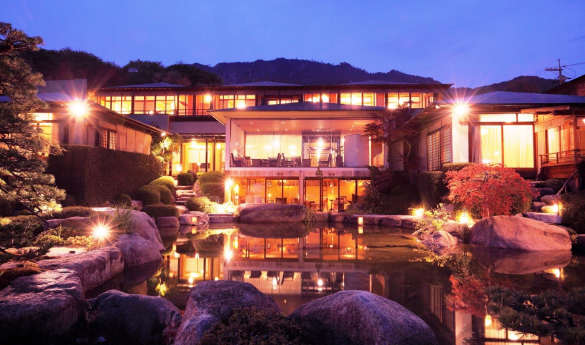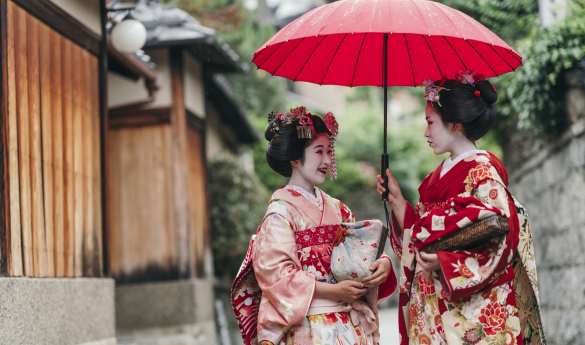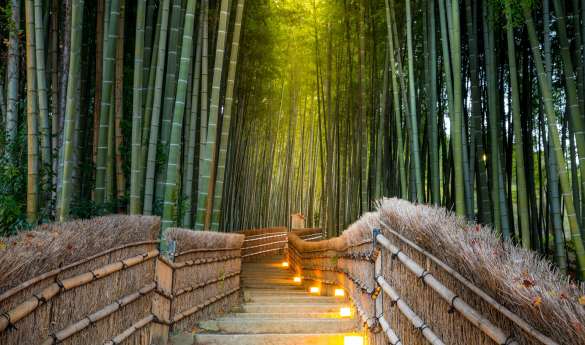Cherry Blossoms in Japan
Japan's cherry blossoms are world-famous for filling the country with the joys of spring and shrouding the country’s already iconic temples and shrines in beautiful hues of pink.

Marking the beginning of spring, the annual arrival of Japan’s cherry blossoms (known as sakura) is of huge cultural significance. Thought to be reminiscent of the beauty and brevity of life, this precious and revered flower is a reminder of Japan’s dramatically contrasting seasons and exquisite natural beauty. The season is a fleeting one; there is about one week from the point the first blossoms open on a tree (known as kaika), to when a full bloom is reached (known as mankai). From this point, the blossoms will stay around for about another week, before falling from the tree and covering the ground in a blanket of pastel pink (strong wind or rain can cut the season shorter still).
However, the cherry blossoms don’t all flower at once; the phenomenon starts in the south of the archipelago and sweeps northwards, which means the blossoms can be observed in different parts of the country for a period of a few months.
As spring gets underway, celebrations sweep across the country in honor of Japan’s most beloved flower. The Japanese indulge in flower-watching parties known as ‘hanami’ – a tradition that has been embraced for many centuries. These can involve anything from a picnic in the shade of a cherry blossom tree to dancing the night away beneath a canopy of pink. However, you choose to join in the festivities, ‘hanami’ will be a highlight of any springtime trip to Japan. As part of these exuberant celebrations, hues of pink become increasingly prominent in Japanese cuisine, culture, and clothing throughout spring.

Where To Go and When
With over 200 species of cherry trees blossoming spontaneously, there are plenty of opportunities to catch the sakura in full bloom throughout Japan, from the ancient parks of Tokyo and the temples of Kyoto to the foothills of Mount Fuji. While Mother Nature offers no guarantees as to when the first buds will begin to blossom, we’ve gained a pretty good idea by studying them over several years.
The first sighting of the famed cherry blossom usually takes place in January or February in the southernmost prefecture of Okinawa, and from here the blooms gradually move north. The most popular places to see the blossoms are on the main island of Honshu, where they tend to arrive around Tokyo and Kyoto between late March and early April. If you miss them there, visitors to the island of Hokkaido can hope to witness the blooms as late as the beginning of May.
Here are a few of our favourite cherry blossom viewing spots:
- Osaka Castle, Osaka
- Philosopher’s Path, Kyoto
- Hakone National Park, Hakone
- Shinjuku Gyoen National Garden, Tokyo
Top Tip: Spring is the most difficult time of year to secure accommodation. Hotels in Japan release their rooms one year before travel, so for the cherry blossom season, they become available in April. We recommend booking as soon as the rooming allocations are released.
Busy This Spring? Try Autumn in Japan
While Japan’s cherry blossoms are truly stunning and celebrating their beauty has become something of a rite of passage for tourists and locals alike, one cannot ignore the fact that these beautiful blooms draw substantial crowds. Accommodation in cherry blossom season books up almost as soon as it becomes available (a year in advance) and prices skyrocket.
If you want to experience a quieter but equally colorful Japan, autumn is a spectacular time of year to visit. Once the summer heat and humidity die down, autumn promises pleasant temperatures, clear skies, and vibrant foliage to rival that of the cherry blossoms. Maple and ginkgo trees mellow into striking oranges and reds, and temples and shrines that were once cloaked in pinks now take on rich autumnal jackets.

We think this is arguably the best time to visit Japan. Stroll beneath Japanese maple trees in the immaculately manicured garden of Kenrokuen in Kanazawa, marvel at the majestic Mount Fuji among rich autumnal colors from the shores of Fuji Five Lakes, and admire Kyoto’s many temples as they glow warmly in shades of yellow, orange, and red.
Did you know? The ginkgo tree is one of the oldest living tree species, first emerging over 200 million years ago.
Call us on 212 372 7009 to start planning your vacation
Why Scott Dunn?
Unique to You

- We listen to your travel goals and craft unique trips that are personalized to you.
- We’re with you every step of your life’s travel journey, from honeymoons to family trips and beyond.
Seamless Service

- Global offices in the UK, US, and Singapore for 24/7 seamless service.
- We offer flexibility if your plans change so you can book with confidence and peace of mind.
Carefully Curated Collection

- We’ve curated an elevated collection of accommodation, experiences, and guides.
- Committed to fostering close global relationships to continue bringing you unique experiences.
Luxury in Every Sense

- We deliver a sense of luxury that matters most to you.
- Awarded Condé Nast Traveler’s Top Travel Specialists in the World 12 years in a row.








